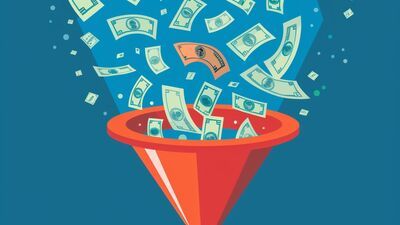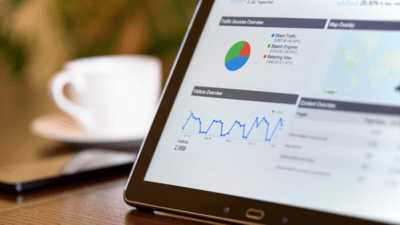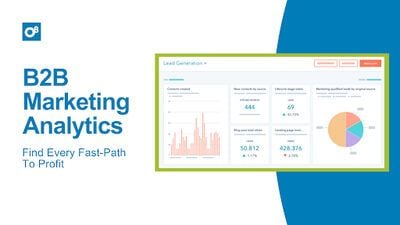
- Summary
- What Is Growth Marketing?
- How Does Growth Marketing Work?
- What Does a Growth Marketing Manager Do?
- Benefits of Growth Marketing
- Examples of Growth Marketing
- Future of Growth Marketing
- How Does Performance Marketing Work?
- What Does a Performance Marketing Manager Do?
- Benefits of Performance Marketing
- Future of Performance Marketing
- Growth Marketing vs. Performance Marketing
- How Growth Marketing and Performance Marketing Work Together in Digital Marketing
- Use Growth Marketing and Performance Marketing in Your Digital Strategy
Growth marketing and performance marketing are similar yet different approaches to digital marketing.
Depending on your business goals, you may use one or the other—or both.
Let’s define growth marketing and performance marketing. Then, we’ll compare and contrast the two and explain how to use each approach in your online marketing strategy.
What Is Growth Marketing?
To understand a growth marketing strategy, you must start with traditional marketing. Typical marketing methods focus on the top of the funnel. For example, a conventional marketer aims to increase brand awareness, traffic, and leads in the awareness and acquisition stages. Then, the sales team handles the rest of the funnel stages.
A growth marketer fixates on the entire funnel. They drive business growth across the organization through each stage: awareness, acquisition, activation, retention, referral, and revenue (AARRR). Growth marketing spans the entire process, from lead generation to customer acquisition to customer retention.
A Word About Growth Hacking
You may have also heard the term “growth hacking” in conversations about growth marketing. Early-stage startups developed growth hacking to grow fast on a small budget. The goal of growth hacking is to achieve product/market fit quickly.
Growth marketing picks up where growth hacking leaves off. It concentrates on brand growth after your business attains product/market fit. Growth hacking drives high-speed growth; growth marketing fosters sustainable growth.
How Does Growth Marketing Work?
At O8, we use a repeatable process and roadmap for growth marketing. We employ various tactics to align, engage, convert, grow, and scale your business.
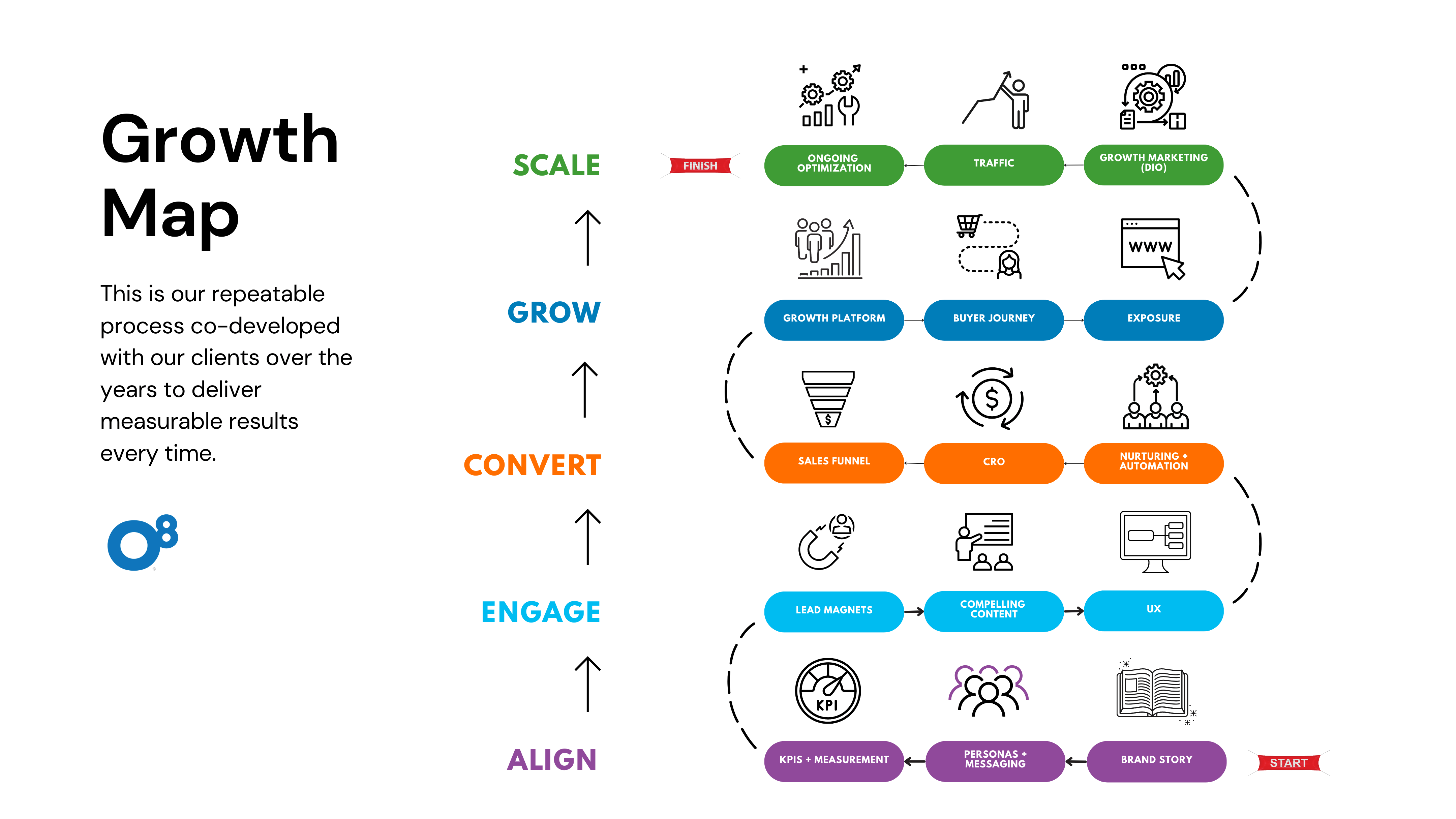
Align
We start with your brand story. Defining your company’s origin, mission, and values evokes emotion from your audience and builds trust. Next, we develop personas based on your ideal customers to ensure your messaging speaks to their pain points. Then, we identify key performance metrics (KPIs) to track and measure the success of your marketing campaigns.
Engage
During this stage, we develop lead magnets to engage your customers and create opportunities for connection. We also produce compelling content that answers customer questions, displays your brand’s authority, and generates organic traffic. In addition, we optimize the user experience (UX) by reducing friction in the buyer’s journey.
Convert
In the converting phase, we use nurturing and automation to gather feedback and strengthen customer relationships. We also deploy conversion rate optimization (CRO) tactics to reveal which parts of your digital ecosystem need to change to increase return on investment (ROI). Plus, we analyze the bottom of the sales funnel to understand where prospects are dropping out so we can convert them instead.
Grow
To expand your business, we create a growth platform with specific initiatives designed to increase revenue and profit. We execute these initiatives at every stage of the buyer’s journey and evaluate internal capabilities for handling new business. As we discover new areas of growth, your brand gets more exposure.
Scale
When your brand is ready to scale, we initiate Digital Integrity Optimization (DIO™️). This framework—which includes CRO, web design, UX, search engine optimization (SEO), pay-per-click (PPC), and other traffic—prioritizes problems and opportunities by business impact. It’s this ongoing optimization that continues to increase your ROI.
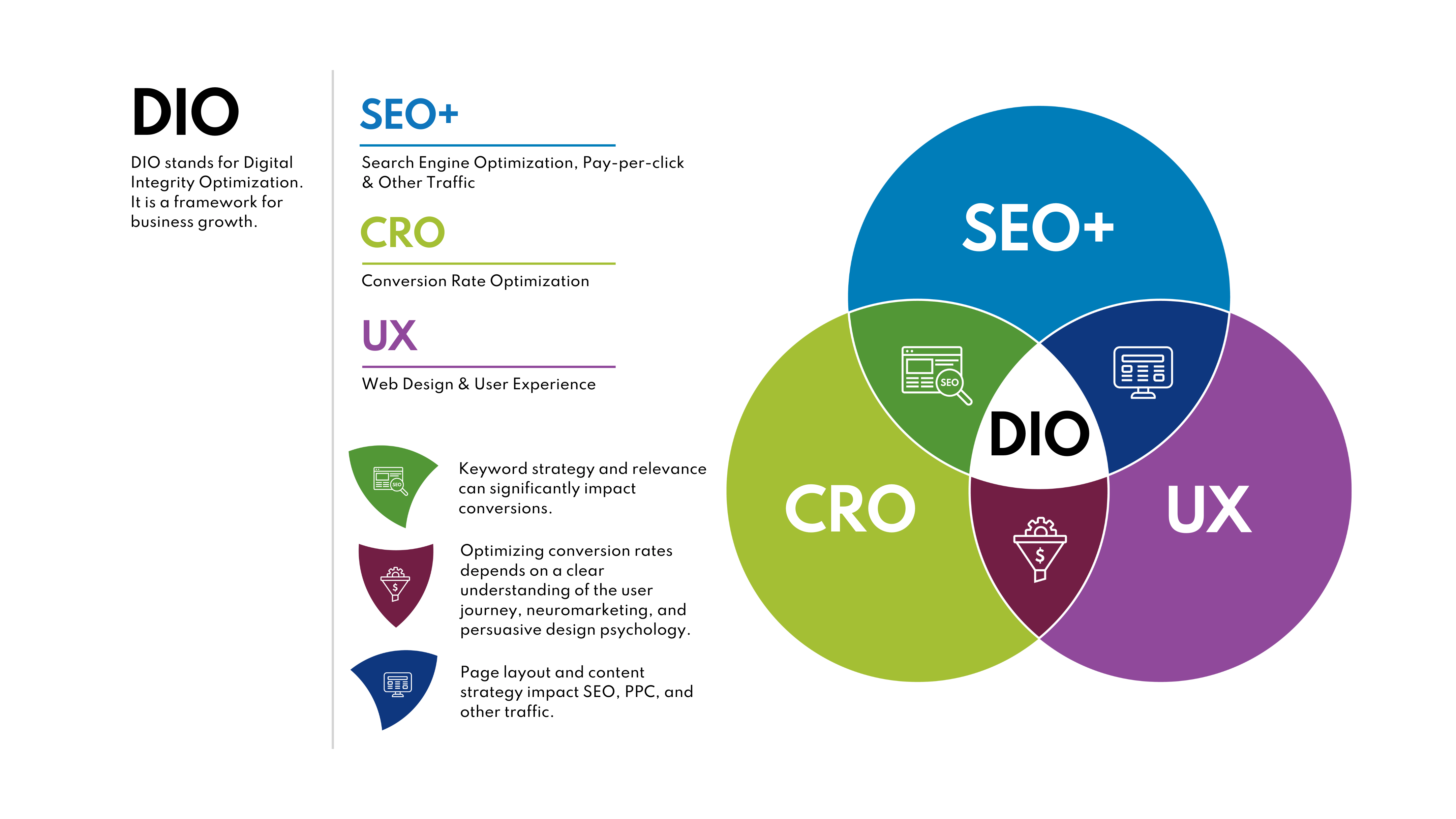
What Does a Growth Marketing Manager Do?
A growth marketing manager takes a step-by-step approach with every channel, source, and funnel stage to find growth opportunities. They use data to identify touchpoints where prospects are leaving at the highest rate and which metrics they need to improve.
To carry out these initiatives, a growth marketing manager develops clear hypotheses, defines experiments, and tests assumptions. These actions ensure that the results are efficient and scalable. A growth marketing manager also works with marketing, operations, product management, analytics, design, and engineering to gather different viewpoints.
Benefits of Growth Marketing
A growth marketer searches every nook and cranny of a business for growth opportunities. This sleuthing has several benefits.
Improved Efficiency
Growth marketers use data to track the effectiveness of their efforts and optimize their strategies in real-time. This transparency helps them get more value out of their marketing budgets.
Greater Focus
Growth marketing is not about generating as much visibility as possible. It’s about identifying your business's most effective marketing channels and tactics. This focus helps your growth marketing team’s efforts become more targeted and strategic.
Data-Driven Decisions
Growth marketers don’t rely on their instincts to choose their next move. They use analytics to inform their decisions. This scientific approach helps them refine strategies and create better outcomes.
Long-Term Results
Sustainable growth is at the heart of growth marketing. It’s not a technique for short-term spikes in traffic or sales. With an aspiration for longevity, growth marketers build a solid foundation for success.
Examples of Growth Marketing
Etsy
More than four million sellers and nearly 40 million buyers use Etsy. The company started in 2005 and found growth opportunities at craft fairs and flea markets. These events helped the startup connect creators with established audiences with its eCommerce platform. Etsy attributes its continued growth to split testing and experimentation.
Slack
Slack grew from 15,000 free users in 2014 to over three million paid users today. The communication tool started by inviting organizations to try out the beta platform. Then, developers drew on user feedback for the next six months to refine the product. Slack continues to use growth marketing to enhance user experience and retain customers.
Zoom
Zoom’s been around since 2011, but it became a household name during the pandemic. Now, this video conferencing tool has more than a half million business customers. The company created a growth loop allowing users to meet with anyone with an email address. This perk enables more prospects to try out the tool and opt for extra features with a paid subscription.
Future of Growth Marketing
Growth marketing is consumer-centric and focused on retention. Marketing teams that want to connect branding, product development, engineering, and design will choose this replicable path for success. Using scientific methods ensures that each aspect of the process is testable, scalable, and trackable.
Interested in uncovering growth opportunities for your business?
How Does Performance Marketing Work?
The main types of performance marketing include social media advertising, search engine marketing (SEM), influencer marketing, and sponsored content.
Social Media Advertising
Social media advertising uses platforms like Facebook, Twitter, and Instagram to promote products and services. Ads may be in the form of sponsored posts, display ads, or video ads. You target certain users based on their interests, demographics, and behaviors.
Search Engine Marketing (SEM)
Search engine marketing (SEM) promotes websites and online content through search engines, such as Google and Bing. You create campaigns with specific keywords and bid on those terms. Then, your ads appear during searches.
Influencer Marketing
Influencer marketing partners your brand with people who have a large online following. It’s particularly effective for reaching younger generations who may distrust traditional advertising. Forms include sponsored posts, product placements, and sponsored events or campaigns.
Sponsored Content
With sponsored content, you pay to have your message featured on a website or platform. It blends in with other content, so it’s more subtle and less disruptive. Forms include articles, videos, podcasts, and social media posts.
What Does a Performance Marketing Manager Do?
A performance marketing manager drives the marketing team's commercial performance. They plan and execute campaigns to meet KPIs. In addition, the performance marketing manager tests new channels and trends to improve ROI. They also allocate and optimize budgets to maximize cost per acquisition (CPA) and scale new customers.
Benefits of Performance Marketing
Performance marketing is a low-risk, ROI-focused strategy with many benefits.
Cost-Effectiveness
Performance marketing drives specific, action-based business goals. So it’s often more cost-effective than other types of marketing. For example, with PPC, you only pay when someone clicks on your ad instead of paying for placements or impressions.
Targeted Reach
With performance marketing, you target certain groups of people based on location, interests, or behaviors. This segmentation helps you reach the right people when they’re looking to buy—increasing your chance of success.
Improved Customer Experiences
Because performance marketing targets certain prospects, you can create more relevant content for your customers. This personalization leads to better engagement and enhanced experiences.
Measurable Results
In performance marketing, results are based on customers completing specific actions. So the outcomes of your efforts are easy to track. When you compare the results to your marketing goals, you can see what’s working and what’s not—and adjust.
Future of Performance Marketing
Performance marketing depends on targeted, personalized campaigns. To succeed, you must know (and learn from) your audience. A/B testing two campaign versions is essential to understand what content performs well. Continuously monitoring performance allows for informed decisions on current and future campaigns.
Want to improve paid search, social, and display ad performance?
Growth Marketing vs. Performance Marketing
While growth marketing and performance marketing share some commonalities, there’s a time and a place for each approach. Here are their similarities and differences.
Growth Marketing and Performance Marketing Similarities
Growth marketing and performance marketing use data and analytics to drive business results. These approaches involve setting specific goals and tracking marketing efforts. Growth marketing and performance marketing also use continuous testing to optimize strategies and improve outcomes.
Growth Marketing and Performance Marketing Differences
What is the key difference between growth marketing and performance marketing?
Growth marketing focuses on the entire funnel, while performance marketing only involves the bottom of the funnel. With growth marketing, you target prospects in each stage of the funnel. In performance marketing, you zero in on people who are most likely ready to take action, like filling out a form or making a purchase.
Growth marketing builds long-term business growth by forming customer relationships. Performance marketing is a short-term strategy to convert new customers quickly. In growth marketing, you rely on a broader range of marketing channels, such as content marketing, social media marketing, and email marketing. With performance marketing, the focus is more on paid platforms, like Google Ads, Facebook Ads, and LinkedIn Ads.
How Growth Marketing and Performance Marketing Work Together in Digital Marketing
Performance marketing can play a role in growth marketing’s holistic approach to digital marketing. Depending on your business status and objectives, you may focus more on one method than the other.
For example, if you’re trying to build a customer base and keep that audience coming back, you should put your efforts into growth marketing tactics. But a performance marketing plan makes more sense if you're an established brand that needs to hit certain KPIs and sales quotas for the month.
Growth marketing and performance marketing work together in digital marketing to cover every stage of the buyer’s journey. Growth marketing builds awareness, attracts potential customers, and keeps customers happy. Performance marketing is an extra nudge that marketers can use when they need to convert prospects into customers quickly.
Use Growth Marketing and Performance Marketing in Your Digital Strategy
You don’t have to choose between growth marketing and performance marketing. There’s room for both approaches in your digital strategy.
O8 offers growth marketing services and performance marketing tactics to grow and scale your business.
Please leave us a note to discuss how our marketing agency can help you succeed.

